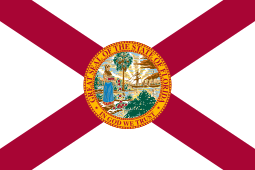Flag of Florida facts for kids
The flag of Florida is the official state flag of Florida. It has a red X-shape, called a saltire, on a white background. In the middle of the flag is the state seal. The flag you see today has been used since May 21, 1985. This was after the Florida state seal was updated and approved for use.
In 2001, a group called the North American Vexillological Association (NAVA) looked at flag designs. They ranked Florida's flag 34th out of 72 flags from Canadian provinces, U.S. states, and U.S. territories. Florida's flag is one of only three U.S. state flags that include the words "In God We Trust". This is the official motto of the United States. The other two states with this motto on their flags are Georgia and Mississippi.
Contents
History of Florida's Flag
Early Spanish Control (1513-1763)

When Juan Ponce de León claimed Florida for Spain on April 2, 1513, Spain was a group of different kingdoms. During the first time Spain controlled Florida, several flags were used. For example, the royal flag of the Crown of Castile was used in Pensacola. The Cross of Burgundy flag was used in St. Augustine. This X-shaped flag was commonly used in Florida to show Spanish independence between 1513 and 1821.
British and Later Spanish Control (1763-1821)
In 1763, Spain gave control of Florida to Great Britain as part of the Treaty of Paris. During this short time, Great Britain used its original union flag in Florida. This flag had white diagonal stripes. The British also split Florida into two parts: East Florida (with its capital in St. Augustine) and West Florida (with its capital in Pensacola).
Spain got Florida back in 1783. In 1785, King Charles III chose a new flag for Spain's navy and battles. This flag had red, gold, and red stripes. It was used along with the Cross of Burgundy flag in East and West Florida until 1821. That's when the Florida provinces joined the United States.
Florida During the Civil War (1821-1868)
Between 1821 and 1861, Florida did not have an official flag. In 1861, Florida decided to leave the Union and called itself a "sovereign and independent nation." During this time, a flag called the Lone Star and Stripes was used as a temporary flag. This flag was originally the navy flag of Texas. It was also used when Florida's forces took control of U.S. forts and a navy yard in Pensacola.
Later that year, the Florida Legislature passed a law. This law allowed Governor Perry to design an official flag. His design looked like the striped flags of the Confederacy. However, it had a blue field that went all the way down, and the new seal of Florida was inside this blue field.
As part of the Confederacy, Florida used all three versions of the Confederate flag. It also used the Bonnie Blue Flag for a short time. This flag has a single five-point star in the center of a blue background. It was used by the short-lived Republic of West Florida in 1810. This republic included parts of what are now Alabama, Mississippi, and Louisiana.
Adding the Red X (1868-Present)
Between 1868 and 1900, Florida's flag was simply the state seal on a white background. However, a later version of the state seal showed a steamboat with a white flag that had a red X-shape. This was similar to Florida's current flag.
In the late 1890s, Governor Francis P. Fleming suggested adding a St. Andrew's Cross (a red X). He thought this would prevent the flag from looking like a white flag of surrender if it hung still on a flagpole. People in Florida voted to approve adding the St. Andrew's Cross in 1900. The red X of the Cross of Burgundy represents the cross where St. Andrew was said to be crucified. You can often see this symbol in Florida's historic places, like St. Augustine, even today.
Some historians believe that Governor Fleming, who fought in the Confederate army, added the red X to honor Florida's role in the Confederacy. This change happened during a time when many people felt nostalgic for the "Lost Cause" idea. Historian John M. Coski notes that Florida's flag change happened around the same time as the start of Jim Crow laws and segregation. These were laws that treated people unfairly based on their race. Other former Confederate states, like Mississippi and Alabama, also adopted new state flags based on Confederate designs around this time.
The flag changes in Mississippi, Alabama, and Florida coincided with the passage of formal Jim Crow segregation laws throughout the South. Four years before Mississippi incorporated a Confederate battle flag into its state flag, its constitutional convention passed pioneering provisions to 'reform' politics by effectively disenfranchising most African Americans.
– John M. Coski, 'The Confederate Battle Flag: America's Most Embattled Emblem (2005), pp. 80–81.
Timeline of Florida's Flags
|
|
|
|
|
|
|
|
See also
 In Spanish: Bandera de la Florida para niños
In Spanish: Bandera de la Florida para niños











